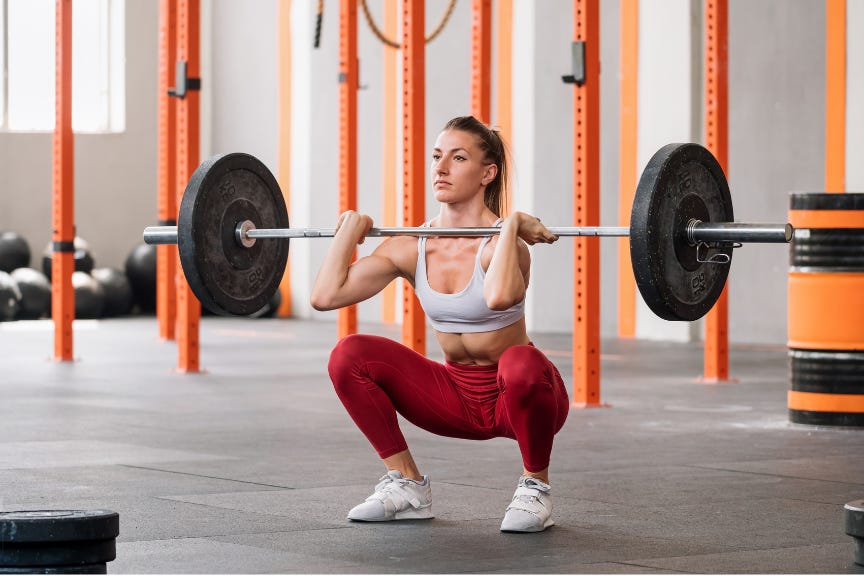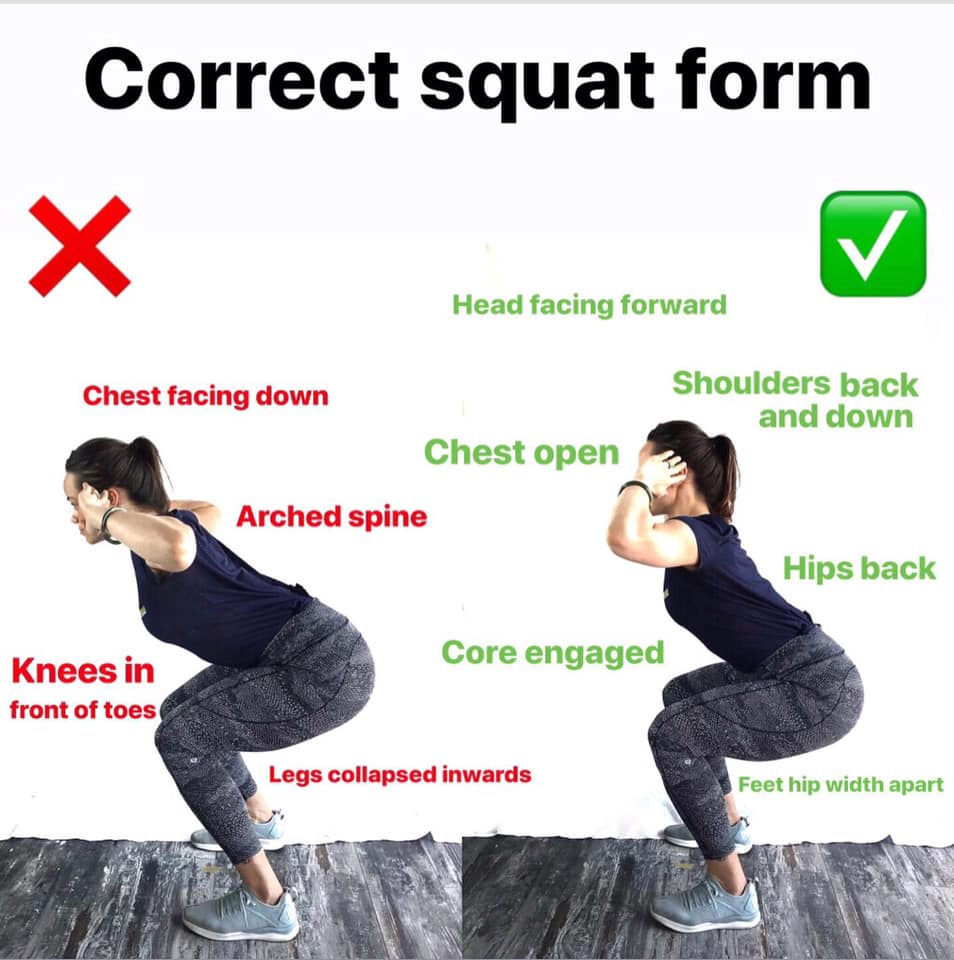Last week, we delved into the benefits of optimizing range of motion for strength training. The workout focus was the push-up and utilizing the hand-release push-up to target the bottom of the movement, where strength is often the weakest.
This week, we will take a look at the squat. Like the push-up, it is a functional movement, and arguably, the most important movement that will maintain your independence into your 8th and 9th decades. We need squat strength to get up and down from a sitting position, for getting up from a fall, and the development of the muscles involved in squatting will also help to keep you from falling in the first place.
From an athletic perspective, squats build a foundation of lower-body strength and power, which is important for explosive movements such as jumping, sprinting, and skating, to name a few. Even if you are not competitive in sport, having the ability to jump and sprint will do wonders for your muscle, bone, and metabolic health when you incorporate these movements into your regular training.
So let’s get into it. Before we even start talking about range of motion, we need to review technique. Sound mechanics not only maximizes the benefits you gain from the movement, but they also keep you safe. This is a big deal with the squat because weight loads tend to be heavier, and this can challenge the spinal column, knees, and ankles.
Squat Faults
Chest Collapse
One of the most common and, frankly, one of the most dangerous faults when lifting heavy, is the collapse of the chest forward. When performing the back squat, if the chest is facing down, as seen below, this moves the bar forward, putting pressure on the spine and the intervertebral discs. This can result from a couple of thing. First, the core muscles may not be strong enough to keep the chest open under the weight of the barbell. The legs may be able to manage this weight, but if the core muscles can’t, this is a setup for injury. Second, there may be mobility constraints from tight anterior shoulder/pectoral muscle constraints that pull the shoulders forward.
Whichever is the case, the way to fix this issue is by going back to an empty barbell or even a PVC pipe, committing to core strengthening and mobility work, and ensuring that you can squat with the chest open before adding weight. As you get stronger in this position, continue to add weight, maintaining the open and upright chest position. Your spine will thank you!
Citation: Flex Fitness New Plymouth
Squat Depth
In the absence of injury or limitations due to pain, the optimal squat depth is where the hip crease drops just below the knees, or when the line between the hips and the knees drops just below parallel. This is best appreciated in the video below.
This is the lowest point in the squat and is often where muscles are the weakest - in part because the tendency is to stop before we hit this point of relative weakness, leaving this range of motion relatively “untrained”.
If you are training alone, you can assess your squat technique by taking a quick video of yourself. It feels a little strange at first, but once you get used to doing it, it is an INCREDIBLY valuable tool for ensuring that you are benefiting the most from your squat range of motion and performing the movement safely. If you are new to this movement, signing up with a coach for 6-8 weeks to help solidify proper technique can be a game-changer and will help you gain confidence with weightlifting.
If you have mobility or injury limitations, the first step is to find your pain-free range of motion. Set up a target like a chair, step, bench, med ball, or a stack of barbell plates behind you, and squat to the lowest depth that is pain-free. Use this target every time you squat, and as you gain strength, re-test your pain-free range of motion. You may find that as your squat strengthens, your range of motion improves!
Other Squat Faults
One could spend a half-day course just on squat mechanics, so for the purposes of this short post, and for the sake of completion, here are a few other technical points to be aware of:
Knees collapsing inward - Another common fault is that the knees drift inward toward the center of the body as you sink deeper into the squat. To fix this you want to focus on driving the knees outward. It may help to turn the toes outward slightly.
Center of weight - Your weight should be centered over the mid-foot. Avoid shifting the weight too far onto the heels or the toes. To test this, you should feel the weight over the arch of your feet, but still be able to wiggle your toes.
Knees tracking over the toes during the movement - This is illustrated in the first graphic above and can put a lot of stress on the knees. The way to fix this is to pull the hips backward to center the knees over the ankles.
Today’s workout is a 2-for-1 where we use the dumbbell / barbell thruster to test squat mechanics and range of motion, as well as squat power (Movement of weight over time), with some plyometrics for bone health, and a treat for your triceps!
Warm Up
Tabata 20:10 (20 seconds of work, 10 seconds of rest) x 6 minutes. Perform each movement in sequence for 20 seconds of work then take 10 seconds of rest until you have completed 4 rounds of the three movements.
Single-under jump rope (or simulated jump rope if no access to a rope)
Easy bench dips
Movement Practice
Take 5-10 minutes to select your weight for the thrusters and set up for your bench dips. Choose a barbell or dumbbell thruster weight that is on the heavier side. Select a weight that allows you to do all 7 repetitions unbroken across the 7 rounds. Be mindful of the fatigue that will be generated by the jump rope and the dips as you select your weight for the dumbbell or barbell thruster!
For the dips, set up a STABLE box, bench, table, or chair and watch the video to ensure proper technique. Select an option that allows you to do the 7 repetitions, ideally unbroken, but in no more than 2 sets during the later rounds).
TIP! 7 rounds is a long time. Manage fatigue by slowing your repetition speed and taking strategic short breaks during the jump-rope and the dips.
Workout
7 rounds for time
7 dumbbell or barbell thrusters (unbroken)
75 single-under jump rope (or 50 double-unders)
7 box dips (ideally unbroken, but alternatively, strategically break up into no more than 2 sets as fatigue sets in)
Score: The time it takes to complete 7 rounds of all three movements. Log your time! You may see this workout again for a re-test!
Alternative: If you are hankering for more volume and lighter weight, try 10 thrusters, 100 single-unders, and 10 dips
No Equipement option:
10 air squats
75 simulated jump rope
10 triceps push-ups (knees or toes, scale by elevating the hands on a STABLE box or bench - increase the incline for easier push-ups)
Cool Down
I bang this drum a lot because it is SO IMPORTANT, particularly for mid-life women, to dial down the stress response, be kind to your muscles and joints, and promote recovery of the body and the mind. Enjoy this post-workout restorative power yoga sequence! #dontskiptheyoga
15-minute post-workout restorative yoga
Housekeeping…
#104 - Women’s Health with Dr. Carla DiGirolamo: Underfueling, The Importance Of Strength Training and PCOS
In this episode, Dr. Carla DiGirolamo, a double board-certified obstetrician-gynecologist and reproductive endocrinologist, joins the conversation to discuss the intersection of fitness, performance, and hormone health. She delves into the science of optimizing health for high-performing individuals, shedding light on hormone therapy, recovery strategies, and how women can train in sync with their physiology. Don’t miss this insightful discussion packed with expert knowledge and practical takeaways. What You’ll Learn:
Hormone Health & Performance – Dr. DiGirolamo explains how hormones impact athletic performance and overall well-being.
Training & Recovery – Insights on optimizing fitness routines and recovery strategies based on hormonal fluctuations.
Menopause & Longevity – Discussion on hormone therapy, its benefits, and misconceptions surrounding menopause.
Women’s Physiology in Fitness – How women can align their training with their natural cycles for better results.
Science-Backed Strategies – Practical approaches to maintaining vitality, strength, and health at every stage of life.
NOW TAKING NEW CLIENTS!
If you are an active woman or competitive midlife athlete who feels abandoned by mainstream medicine, I’m here for you!
It is with great excitement that after more than 2 years of preparation, I have FINALLY launched my Telehealth Consultation Medical practice focusing on the Reproductive Endocrine needs and Menopausal Care for active, athletic, and high-performing women.
Active and athletic midlife women have needs and risk profiles that are different from the general population. These needs often go unmet by the mainstream medical community due to a lack of understanding of fitness and sport and their impact on mid-life hormonal physiology or even a lack of acknowledgment that this dynamic exists. We put your health, fitness, and performance at the center of the equation so that you can achieve your healthiest, highest-performing self!
You will find all my service offerings on my website including a link to my calendar so that you can reserve your place in my schedule!






This is really helpful. I’ve been trying to do more weight training. So important as we age.
this is such a powerful exercise. the key is getting the form right.